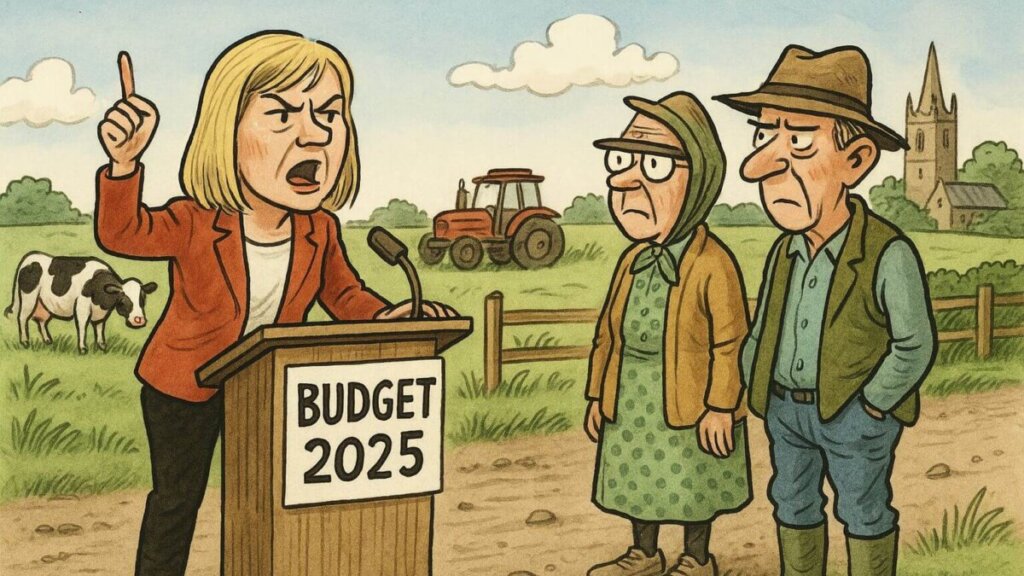Tax rises, rising costs and no plan for growth. That is the story of this year’s Autumn Budget. The figures now published by the Office for Budget Responsibility, the Institute for Fiscal Studies and local government finance bodies make it clear. This Budget asks you to pay more while giving little back to Lincolnshire or the wider countryside.
Half an hour before the Chancellor stood up, the OBR accidentally released the whole economic outlook. It removed any suspense. Growth is down, inflation is up, and the tax burden is heading to a record level. For a county like ours, built on work, farming, small business and long rural journeys, the detail matters. And the detail does not look good.
The most significant tax rise in more than fifty years
The IFS graph told the story straight. The tax rises announced in this parliament are larger than in any parliament since 1970. This Budget adds another £26 billion. Threshold freezes continue, pulling more people into higher tax bands. This means Lincolnshire families on ordinary incomes will pay more even if their pay does not keep pace with prices.
The Chancellor once said that extending the freezes would “hurt working people”. She did it anyway.
A weaker economy and rising costs
The OBR figures are precise.
Growth is revised down every year from 2026 to 2029.
Inflation rises again in 2025 and 2026.
Borrowing rises by £11 billion.
Debt interest reaches £136.6 billion by 2030.
Unemployment starts to climb again.
For people here, this means higher prices for longer, fewer job opportunities and a weaker outlook for businesses across the county. Nothing in this Budget sets out a route to reverse that.
Local services: no new funding and new risks
Despite all these tax rises, the Budget gives no new core funding for local Government. It also announces a future 0.5 per cent cut to departmental budgets from 2028, which hits local government grant funding. Councils will have to do more with less.
At the same time, the Government expects council tax to increase by 5 per cent each year throughout the parliament. This moves more of the cost of national decisions onto households.
SEND remains the most serious pressure. The statutory override ends in 2028. The OBR warns this could trigger widespread Section 114 notices unless a credible solution is found for historic deficits. County councils have raised this risk for several years. The Budget still gives no clear answer.
A poor deal for rural Lincolnshire
The Countryside Alliance’s assessment gives a clear rural perspective. Their view aligns with what many here feel. Rural communities did not get the attention they needed.
Family Farm Tax is still going ahead.
Last year’s changes to Agricultural Property Relief and Business Property Relief remain in place. These rules start in April 2026. A slight tweak on the spousal allowance will help a few families, but it does not fix the core problem. Many farms could struggle to pass on the business to the next generation. Lincolnshire is one of the most farming-dependent counties in England. This decision matters.
Heating oil left untouched.
The Government refused to cut VAT on heating oil. Many rural homes in Lincolnshire rely on oil. There were calls from across the sector to fix this. Nothing changed.
Fuel duty: only a temporary extension
The 5 p.m. cut remains in place for now, but only until August 2026—no long-term stability for rural drivers. When you live in a rural county, every cost linked to transport hits harder.
Electric vehicle mileage tax
The new pay-per-mile system starts in 2028. On paper, it looks simple. In practice, it ignores rural life: longer journeys, less public transport, fewer charging points. Rural drivers will carry a bigger share of the cost unless the design changes.
Pubs and small businesses
There is one positive. From 2026, pubs and small hospitality businesses will pay a lower business rates multiplier. That helps rural high streets and village pubs. But alcohol duty rises in February, which cuts into that benefit.
Connectivity and planning
Extra planners may help address delays, but the focus remains on large projects rather than rural needs. The broadband measures still skew towards urban rollout. Not much changes for villages or isolated areas.
In short, there is no rural strategy in this Budget. Rural proofing is still missing.
Roads, transport and long-term promises
The Budget repeats the pledge that local road funding will rise to over £2 billion a year by 2029–30. This may help the next parliament, but it does little for councils dealing with damaged roads right now.
There is no extra support for adult social care, fire and rescue, or local policing. These are pressures that do not wait for long-term budget cycles.
What this means for Lincolnshire
Lincolnshire residents now face:
- Higher income tax due to frozen thresholds
- Higher council tax each year
- Higher driving and heating costs in rural areas
- Higher inflation than forecast last spring
- No improvement in local services
- No clearer plan for SEND
- No extra support for family farms, rural pubs or rural households
Meanwhile, the county continues to absorb national policy pressures without the funding to match.
Why it matters
Lincolnshire relies on people who work hard and contribute. We rely on farming, manufacturing, logistics and small businesses. We rely on good roads, strong local services and a fair tax system that reflects rural realities. This Budget does not reflect those realities.
Lincolnshire Conservatives believe that tax should be fair, that growth should be a priority, and that rural communities should not be an afterthought. That means reducing waste, reforming welfare, cutting taxes on work, and supporting the services people use every day.
Lincolnshire stands ready to work with any government that understands this. For now, we will continue to make the case for a fairer deal for our county.
